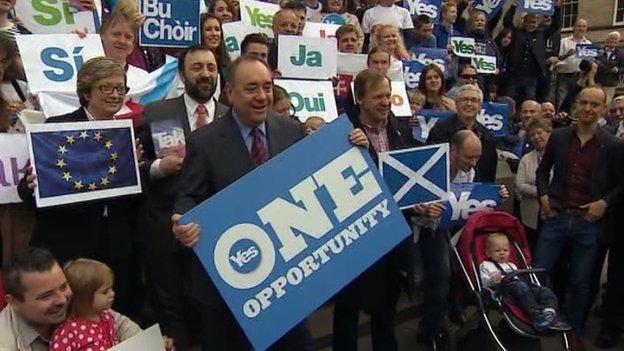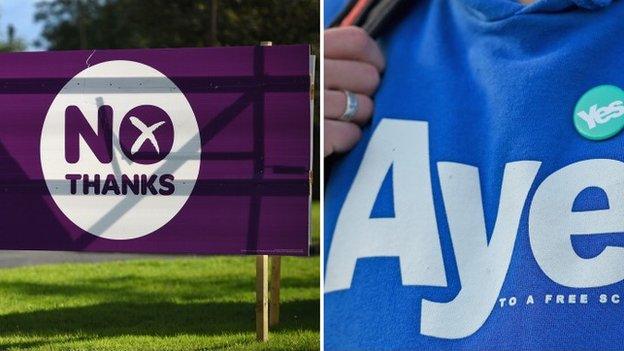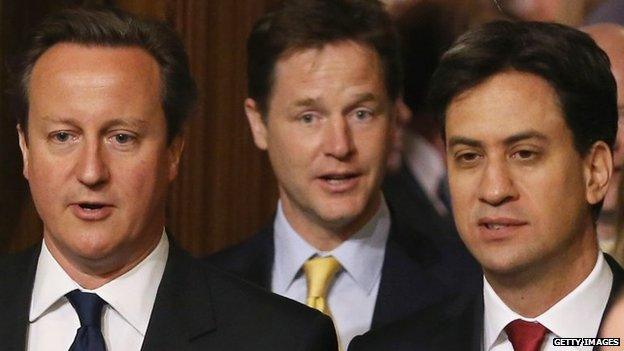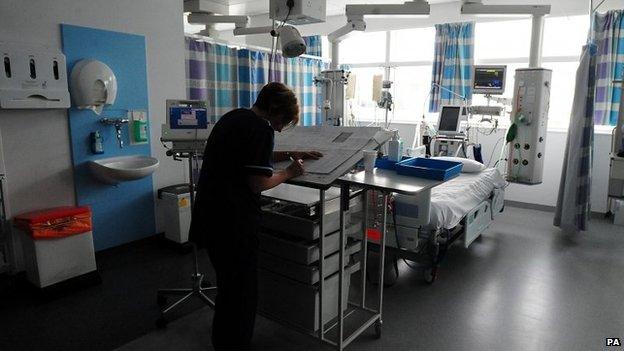Symbolism and pragmatism
- Published

The Scottish leaders of the three main pro-Union parties backed a timetable for more powers
Symbolism all around. Behind the three pro-Union Scottish party leaders, the Holyrood Parliament. Beyond, in the distance, Calton Hill where they previously declared their joint support for more devolved power.
And the first minister?
On the steps of St Giles - the High Kirk, an iconic centre-piece in Scotland's long history, not least in 1637 when Jenny Geddes protested against the use of the Anglican prayer book by hurling a stool at the minister.
Pragmatism too.
The Union supporters hope that their promise of a timetable for more powers will be sufficient to counter the apparent move towards support for independence, indicated in polls.
From the first minister, an argument that Scotland requires the full powers of independence in order to ensure that governance of the people is always in line with popular choice.
At Westminster, the three leaders of the pro-Union parties announce that they are to abandon the weekly session of prime minister's questions in favour of a trip - or rather trips - to Scotland. (They will campaign individually, not collectively.)
Minds concentrated
So what is happening? Those polls, of course.
Is it panic? Not remotely, we are assured. "Crisis, what crisis?" as Jim Callaghan did not say.
At the very least, however, minds have been sharply concentrated.

Alex Salmond argued that Scotland needs the full powers of independence
To be fair, there have been elements on the No side who have argued internally for some time that the offer of more powers was not sufficiently well calibrated to be truly effective. Ideally, those elements would like to have seen a unified, combined offer.
Not possible: too little time, too much disagreement.
So those elements turned some time back to the argument that the disparate offer must be accompanied by a timetable to give a stronger assurance that implementation was a serious prospect.
To be clear, no new powers have emerged.
We still have on the table the three distinct offers from Labour, the Liberal Democrats and the Conservatives. Those have been tabled for some time.
In the mix, we have had the suggestion from the Scottish Secretary Alistair Carmichael that a forum should be convened within 30 days of the referendum to seek consensus.
But, other than that, it had been presumed to some extent that the implementation of new powers would be driven in practice by whoever won the May 2015 UK general election. To be clear, once more, that was always open to amendment.
Common timetable
Now, that position has demonstrably changed. All three parties have signed up to the notion of formulating a common plan to a timetable.
The timetable itself contains symbolism.
A White Paper by St Andrew's Day. A bill by Burns Night. (Understandably, less attention is drawn to another key date: a consultation paper by 31 October - Hallowe'en.)
But the pragmatic implication is that, whoever wins the UK election, the consensual package which eventually emerges will be implemented. It will be on the stocks, waiting.
Now, within that, a degree of tension. For reasons of choreography and character, this initiative has been led by Gordon Brown. As one insider observed, when Mr Brown speaks, folk in Scotland tend to listen.
That meant - again, deliberately - that this was a Labour initiative, reflecting the party's leading role in the pro-Union campaign in Scotland. It was not the present prime minister but his predecessor who was seen to take the lead.

Polls have suggested the pro-Union and pro-independence campaigns are neck and neck
Were the other party leaders bounced? No, they were consulted.
Was the consultation long and enduring with ideas knocked around? Not really, no.
It was driven by Gordon Brown and the others recognised the value of unity in the face of the polls.
Since when, the Tories and the Lib Dems have had to thole the occasional depiction of this initiative as being a Labour plan to be implemented by a Labour government.
To be fair, Johann Lamont acknowledged, when I asked her, that it might fall to be introduced by a government other than one led by her party. But Labour is in the vanguard.
However, it might be Labour which has to offer concessions, should the need arise. If Scotland votes no, Labour might have to give ground on its plan for more powers.
'Enhanced' plan?
So what might emerge? Perhaps an enhancement of Labour's tax plan, moving closer - if not entirely in line with - the Tory and Lib Dem proposals to devolve income tax. Other Lib Dem transfers, such as inheritance tax and corporation tax, would be negotiated.
On welfare, housing benefit and attendance allowance seem agreed as targets for devolution.
But no transfer of corporation tax, VAT, national insurance, duties or oil revenue. As in the three existing plans.
The Tories would have to concede Labour's demand that there should be no reduction in the number of Scottish MPs at Westminster.
The Barnett Formula, which determines Scottish spending by comparison with English spending departments, would stay; the LibDems having reversed their previous policy of suggesting a needs-based assessment.

David Cameron, Nick Clegg and Ed Miliband have decided to campaign in Scotland ahead of the referendum
To be clear once more, that deal is not on the table at the moment. Not in any form.
We are still presented with three plans, which leads Alex Salmond to make three points.
One, people in Scotland are being asked to vote "No" without knowing what the final alternative package might be.
Two, the timetable for implementation is exceptionally tight.
And three, even if a deal emerges on income tax, it will fall far short of what is required in Scotland to boost the economy and create jobs.
NHS campaign
Then there is the NHS. The Union parties say that the talk of a threat is bogus, that it is misplaced. Nevertheless, they have felt constrained by the apparent success of this initiative to address it today.
The proposition by supporters of independence is that cuts in overall spending will, through the Barnett Formula, place strain on Scotland. Further, they assert that health privatisation in England, if it involves NHS charging, might thereby reduce public spend and thus cut the money available to Scotland.
Supporters of the Union say that, in practice, there is little chance of such a radical departure from NHS provision in England. Supporters of independence say that cannot be guaranteed: that there is an intrinsic risk in the Union.

The NHS has become a key battleground in the independence referendum
So, say unionists, today's offer is an answer.
Give Scotland sufficient financial clout and the Scottish Parliament can countermand any institutional cuts washing over from England. They can do this by deploying the new tax powers.
In short, if England opts for an NHS severely reduced in scale, Scotland can choose a different path - and take the tax hit.
Supporters of independence say that is technically available at the moment - through the "Tartan Tax", the power to vary the Scottish basic rate of income tax by +/- 3%. They say Scotland requires full financial powers to stimulate the economy and mitigate austerity.
So, in summary. The independence offer remains and is being evangelised vigorously.
The "more powers" offers are as they were - but with the caveat that there is a precise timetable for action. A guarantee, say supporters.
As ever, the people will choose.